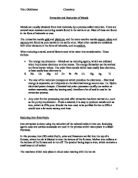The decompose of a mercury cathode
cell
On the other hand, the membrane cell solves this problem by inserting a modern membrane into the cell. This membrane allows cations such as 2Na+ (aq) to pass through it, but not anions like 2Cl-(aq) On one side brine is in contact with a titanium anode and chloride ions are discharged producing chlorine gas. The sodium ions pass through the membrane into dilute sodium hydroxide solution. Hydrogen gas and hydroxide ions are liberated from water at the cathode.
[2]
Diagram of the membrane cell
During the 19th century, iodine was discovered. This therefore caused the first method of iodine extraction to come about. Before the element was discovered kelp was burnt to create gunpowder, an explosive. However, Bernard Courtois found iodine present in this kelp when violet fumes were produced when more concentrated sulphuric acid was added to the sludge. It was understood that the sulphuric acid was a powerful enough oxidising agent to convert iodide ions into iodine molecules.
2I- (s) + 3H2SO4 (l) I2 (g) + 2H2O (l) + SO2 (g) + 2H2SO4- (s)
8I- (s) + 4H+ (aq) + 5H2SO4 (l) H2S(g) + 4HSO4- (s) + 4I2 (g) + 4H2O (l)
Research at St Andrews University showed that the yield of iodine could be maximised by drying the seaweed. This method of burning kelp lasted until 1930.
Extraction of iodine from brine and nitrate ores has become the two major sources of the element most recently. Both of these extractions occur due to redox reactions and can be shown by the following reactions:
Step One. Brine is reacted with chlorine:
2I- (aq) + Cl2 (g) I2 (aq) + 2Cl- (aq)
Step Two. Sulphur dioxide is added to reduce vaporised iodine:
SO2 (g) + I2 (aq) + H2O (l) 2H+ (aq) + 2I- (aq) + H2SO4 (aq)
Step one is now repeated to form a higher concentration of iodine than its solubility, so that iodine crystals separate and can be recovered by filtration.
From Nitrate ores, iodine is formed from iodate (V) ions IO3- (Sodium iodate (V)). During this method, sodium nitrate ore is leached with water which results in the sodium nitrate to crystallise when cooling. After these crystals are separated, a spray of this solution I passed into sulphur dioxide with reduces the iodate (V) ions.
IO3- (aq) + 3SO2 (g) + 3H2O (l) I- (aq) + 6H+ (aq) + 3SO42- (aq)
To liberate the iodine, the resulting solution is mixed with a small quantity of the iodate (V) solution
IO3- (aq) + 5I- (aq) + 6H+ (aq) 3I2 (aq) + 3H2O (l)
Again, the iodine separates as a solid, however, this time; it is extracted with a hydrocarbon solvent instead of being filtered. The hydrocarbon is passed into a reactor where the temperature and pressure is raised, to allow the hydrocarbon to evaporate and the iodine to melt. The latter is poured into cold air to give solidified droplets called prill. [1]
The modern methods of extracting the halogens, chlorine and iodine, are extremely different, however, they do involve certain similarities. As previously stated, iodine is currently extracted from brine and nitrate ores by redox reactions and then separation by filtering or with the use of another substance i.e. hydrocarbons.
The most modern method of extraction of chlorine was patented in 1960; this method involves a membrane to be placed in the cell.
The membrane allows cations to pass through but not anions, or water molecules. On one side brine is in contact with a titanium anode and chloride ions are discharged producing chlorine gas. The sodium ions pass through the membrane into dilute sodium hydroxide solution. The Membrane Cell
Electrons are supplied by a steel cathode
to the water to liberate hydrogen gas and hydroxide ions. [2]
As it is apparent electrodes are not present in the method of extracting iodine, this is due to a few reasons:
- If a current was passed through brine, due to the composition of saltwater, chlorine would also be produced along with a very small amount of iodine as sodium chloride is present. This therefore would cause the iodine to be contaminated and extremely dilute.
- In connection with the nitrate ore, if electrodes were used to extract iodine, nitrate would also be formed alone with iodine. It is evident from the following diagram that as nitrate is a negatively charged ion it would also be discharged at the anode.
This therefore results in the present methods of extracting iodine to be used as it allows a high concentration of uncontaminated iodine to be formed. Each of the processes used for both halogens are extremely efficient.
Membrane cell used for nitrate ore
[2]
References:
[1] Article 1: Napoleon’s legacy: riches from the seas, adapted from articles by Margaret Ferguson, Chemistry Review, 2000, Volume 10, Number 1, and P A Swain, School Science Review, 1994, 75 (273)
[2] Article 2: The Salt of the Earth, adapted from the article Salt: The essential chemical by Bill Fox, Chemistry Review, 1996, Volume 6, Number 2







